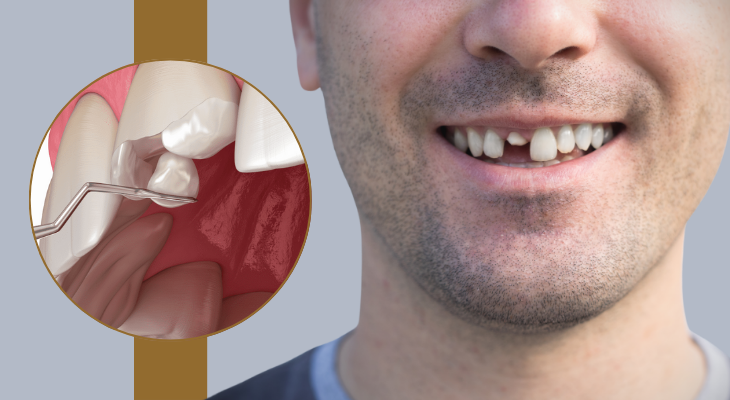
Best Tooth Fracture Treatment East Delhi
At Veda Dentistry, we offer effective treatment options for tooth fractures, ensuring the restoration of your smile. Tooth fractures can be addressed through a variety of methods, including composite restorations, dental crowns, and, in some cases, dental veneers. Our goal is to help you achieve a beautiful, functional smile with our tooth fracture treatment in East Delhi.
Causes of Tooth Fractures
Tooth fractures can occur due to several reasons, including:
-
Teeth Grinding or Clenching: Often caused by stress or sleep disorders.
-
Extensive Fillings: Large fillings can weaken the tooth structure.
-
Biting Hard Foods: Foods like walnuts or ice can cause fractures.
-
Trauma or Injury: Accidents or contact sports can lead to tooth fractures.
-
Age: Teeth tend to become more brittle over time, especially after the age of 50.
Symptoms of Tooth Fractures
Common symptoms of a tooth fracture include:
-
Pain while Biting or Chewing: Discomfort is often triggered during chewing or biting.
-
Pain upon Releasing the Bite: In cracked teeth, pain is typically felt when releasing pressure.
-
Sensitivity: You may experience sensitivity to hot or cold items.
-
Spontaneous Pain: Pain may occur without a clear trigger, but it is often intermittent.
-
Swelling: The surrounding gums or soft tissues may swell.
Types of Tooth Fractures
Tooth fractures are categorized into several types:
-
Craze Lines: Minor cracks on the tooth's outer surface, usually requiring no treatment.
-
Fractured Cusp: A small portion of the tooth breaks off, often due to large fillings, but without involving the nerves or blood vessels.
-
Split Tooth: A more serious fracture that extends beneath the gums, splitting the tooth into two parts.
-
Vertical Tooth Fracture: A severe fracture that involves the entire tooth structure, often requiring urgent treatment.
Complications of Untreated Tooth Fractures
If left untreated, a tooth fracture can lead to several complications:
-
Infection: A cracked tooth may lead to an infection that spreads to the gums and bones.
-
Pain: Increased sensitivity and discomfort while chewing.
-
Swelling and Tenderness: Gum swelling, fever, or bad breath.
-
Tooth Decay: If the fracture allows bacteria to enter the tooth, decay may develop.
Options for Tooth Fracture Treatment in East Delhi
Several treatment options are available, depending on the severity and location of the fracture:
Composite Bonding:
For small fractures or chips, composite bonding is an excellent option. A tooth-colored material is applied to the affected area to restore the tooth’s natural shape. This procedure is quick and usually completed in one visit.
Root Canal Treatment (RCT):
If the fracture involves the tooth’s nerves or blood vessels, a root canal may be necessary. This procedure removes the damaged pulp and prevents further deterioration of the tooth.
Dental Crowns:
A dental crown is a cap that fits over the damaged tooth, providing strength and protection. Crowns are typically made of porcelain, metal, or a combination of both. The procedure usually requires two visits, and the treatment is painless.
Dental Veneers:
Veneers are thin, durable shells that cover the front of the tooth to mask any cracks or chips. Depending on the severity of the fracture, composite or porcelain veneers may be recommended.
Self-Care and Prevention of Tooth Fractures
While tooth fracture treatment requires professional care, there are ways to prevent fractures from occurring:
-
Avoid Hard Foods: Steer clear of hard foods like nuts and ice.
-
Don’t Use Teeth as Tools: Never open bottles or chew on non-food objects like pens.
-
Wear a Mouthguard: If you play contact sports, always wear a protective mouthguard to prevent injuries.
FAQs
1. How can I tell if I have a cracked tooth?
Common signs include pain while chewing or biting, sensitivity to hot or cold, and spontaneous pain that isn't continuous. If you suspect a cracked tooth, it’s important to visit a dentist for a precise diagnosis and appropriate treatment.
2. What is the treatment for a tooth fracture?
Treatment depends on the severity of the fracture. Options include composite bonding for minor fractures, root canal treatment for more severe damage involving nerves, and dental crowns or veneers for substantial fractures
3. Is a fractured tooth always painful?
Not always. While some fractures cause pain when chewing or biting, others may not hurt at all, especially if the fracture is minor. However, if left untreated, the fracture could lead to infection and increased pain.
4. How much does tooth fracture treatment cost in East Delhi?
The cost of treating a tooth fracture depends on various factors such as the type of fracture, the treatment required (e.g., bonding, root canal, crown, or veneer), and the complexity of the case. Other factors, like the materials used (porcelain vs. composite), and the dentist's expertise, also play a role. For a more accurate estimate, it’s best to consult with our experts at Veda Dentistry.


Book An Appointment